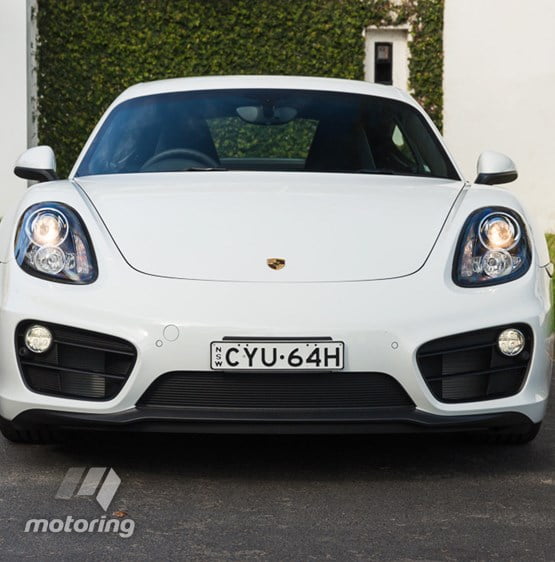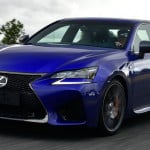Porsche’s Cayman GTS won our Australia’s Best Driver’s Cars award earlier this year, and the base model and mid-range Cayman S are worthy stablemates. But there’s trouble brewing for Porsche’s small sports car, which is anticipated to adopt turbocharged four-cylinder power next year. At that time it’s speculated the Cayman will be repositioned below the Boxster, having relinquished its performance advantage. That makes the current MY16 Cayman a car to covet for Porsche traditionalists.
Almost $80,000 separates the entry-level Porsche Cayman from its range-topping counterpart, the Cayman GT4.
Even the mid-range Cayman S is $32,800 more than the base-grade variant. Yet the 2.7-litre Cayman lacks relatively little, as we learned from pitting it against the 3.4-litre Cayman S. Buyers do get 19-inch alloy wheels (versus 18-inch alloys), the larger engine, added leather upholstery and bi-xenon headlights for that extra money.
The highlight in that list is the larger powerplant, which stumps up 37kW and 80Nm extra, for a 0-100km time of 4.9 seconds. And that’s 0.7 seconds better than the 2.7-litre model’s time.
The naturally balanced flat-six engines restart automatically with almost no rocking or thumping when turned over by the auto-stop/start system. Nevertheless, you’re constantly aware of the engines’ presence, sitting just behind the front seats. But then, noisy as they are, they’re noisy like Van Halen with David Lee Roth on lead vocals.
At cruising speeds both engines faded into the background, leaving tyre noise as the dominant source of NVH.
There’s plenty of thrust from the mid-range (around 3500rpm) once you begin working the 2.7-litre engine a bit harder. Each individual cylinder firing sounds like a single metallic gunshot from a semi-automatic assault rifle. There’s a mad bass undertone as well and the whole lot comes together like some sort of demonically up-tempo anthem. The 3.4-litre engine takes the soundtrack to a higher level still.
Both cars were fitted with Porsche’s dual-clutch transmission, the seven-speed PDK. Stamping on the accelerator from standstill induced the base Cayman’s PDK to slip the clutch until the engine reached around 4000rpm. Launched the same way, the 3.4-litre was producing useful torque and power from below 3000rpm. There was a very real difference in power delivery between the two cars, but it was less obvious in day-to-day driving.
Long-term average fuel consumption, according to the base Cayman’s trip computer, was 10.7L/100km, rising to 10.8 after a week. For the Cayman S it was 11.8L/100km. Both cars hovered around an average of 13L/100km over the course of the week.
The transmission shifted quickly but smoothly, with buttons to change up or down. At low speeds the PDK box clanked as it disengaged drive between the engine and the rear axle. This was more noticeable in the base Cayman than the higher-performance Cayman S.
Jump on the accelerator for a hill start too suddenly and the brakes would grind lightly as they belatedly released. This was not apparent in the Cayman S, although the higher-performance model did suffer from badly squealing brakes at lower speeds.
The Cayman’s steering was heavy in both cars, but that heaviness helped the driver feel very connected with each car. Steering response was adroit and provided the braking was done early there was enough weight over the front end for the car to tuck in without pushing through the corner. From there it was simply a matter of feeding the power to the wheels in small increments.
When the corner tightened and the car did start to understeer, raising the right foot a little helped it maintain the line. In tighter turns and with the entry attitude and speed right you could bury the right foot in the carpet and the Cayman would step out – but not without active safety systems clamping down on the oversteer.
As fun as the Cayman’s cornering was, it’s a car to be treated with some respect once the heavens open. The Cayman S on a rainy night produced a heart-stopping moment on the entry into one corner, but the stability control could be relied on to straighten the car with plenty of margin for error at lower speeds.
Both cars rode firmly and the ride could be choppy on typical country roads. Braking power was immense and the Cayman S in particular felt very planted under brakes, with tonnes of pedal feel.
Climbing in and out of the Cayman is not for those lacking litheness and flexibility. Petite drivers will cope easily enough with the long doors in car parks, but for men of average height the Cayman needs a lot more parking space than its compact footprint would suggest.
Once inside, the Cayman’s driving position is fantastic. While the seat cushioning is firm, you’re supported everywhere and won’t slide around in corners. The seats are aggressively bolstered, but well-shaped and offer the flexibility of a motor-driven extending base, for under-thigh support, and powered lumbar adjustment.
Like many European prestige cars, the Cayman’s instrumentation and control layout take some familiarity to understand. The myriad infotainment and climate control switchgear in the centre fascia make for a complex presentation, and pressing the audio source button, as one example, is finicky.
After starting the Cayman (both of them), several seconds would pass before the car connected to a previously paired Bluetooth phone. Changing from default radio at start-up to the phone for music streaming had to be done manually every time.
The parking brake follows Benz’s model, with a finger pull on the lower right to release or activate (by pushing). Knocked across to the left, the conventional shift lever provides sportier operation and sequential shifting, but the shift ‘paddles’ on the steering wheel spokes – actually finger grips that operate in both directions – are a legacy of Porsche’s insistence that each one can shift up as well as down. Pulling back for downshifts and pushing forward for upshifts is puzzling when most other companies place the downshift paddle on the left and the upshift paddle on the right.
But once familiar the sequential-shift controls are a very impressive means of changing gear. More than practically any similar system I’ve experienced it’s possible to leave both hands firmly fixed to the wheel in the Cayman while shifting up or down. That says much about the Porsche’s direct steering and low number of turns lock to lock.
The Cayman’s instrumentation is another point of difference. In keeping with Porsche tradition, the speedo is on the left in a smaller dial, and the tachometer sits in a larger dial directly in front of the driver. It’s easier to watch the speed using the digital readout within the tachometer. The analogue speedo has finely spaced calibrations that are not equidistant.
That said, the engine braking available courtesy of the adaptive PDK keeps the speed from creeping up on downhill grades. If anything, you actually have to keep an eye on the car’s speed constantly to ensure it doesn’t fall well below the speed limit, particularly with the larger-engined Cayman S.
 On the right of the instrument binnacle is an information display that scrolls through vehicle operation (tyre pressures), trip computer and infotainment facilities. Below the base Cayman’s wiper stalk on the right of the steering column there’s another stalk to scroll and select the different infotainment items.
On the right of the instrument binnacle is an information display that scrolls through vehicle operation (tyre pressures), trip computer and infotainment facilities. Below the base Cayman’s wiper stalk on the right of the steering column there’s another stalk to scroll and select the different infotainment items.
In the Cayman S, the instrumentation is largely the same, but instead of that separate stalk for infotainment, the more expensive Cayman variant features a scrolling button on the right spoke of the steering wheel to select different trip computer displays.
Being sports cars, neither Cayman variant is especially practical for family ferrying duties or bringing home the bacon (and the vegies, toiletries and other paraphernalia of domesticated bliss). The rear boot will take a couple of overnight bags, and the front boot looks deep and wide enough for two medium-sized suitcases, however.
[“source-motoring”]





